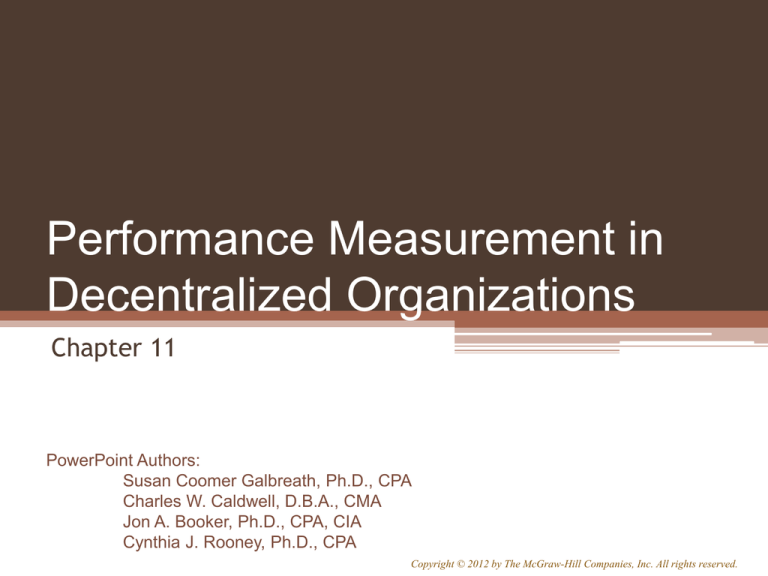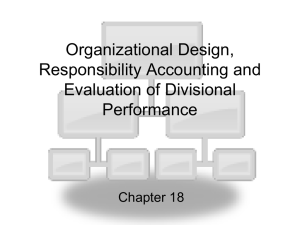
Performance Measurement in
Decentralized Organizations
Chapter 11
PowerPoint Authors:
Susan Coomer Galbreath, Ph.D., CPA
Charles W. Caldwell, D.B.A., CMA
Jon A. Booker, Ph.D., CPA, CIA
Cynthia J. Rooney, Ph.D., CPA
Copyright © 2012 by The McGraw-Hill Companies, Inc. All rights reserved.
11-2
Cost, Profit, and Investments Centers
Cost
Center
Cost, profit,
and investment
centers are all
known as
responsibility
centers.
Profit
Center
Responsibility
Center
Investment
Center
11-3
Cost Center
A segment whose manager has control over
costs, but not over revenues or investment
funds.
11-4
Profit Center
A segment whose
manager has control
over both costs and
revenues,
but no control over
investment funds.
Revenues
Sales
Interest
Other
Costs
Mfg. costs
Commissions
Salaries
Other
11-5
Investment Center
Corporate Headquarters
A segment whose
manager has control
over costs,
revenues, and
investments in
operating assets.
11-6
Responsibility Centers
Investment
Centers
O p e ratio ns
V ic e P re sid e nt
S a lty S na c ks
P ro d u c t M a n g er
B o ttlin g P la nt
M a na g er
B e vera g es
P ro d u c t M a n a g er
W a reh o u se
M a na g er
S u p e rio r F o o ds C o rp o ra tion
C o rp o rate H e a dq u a rte rs
P re s ide n t a nd C EO
F in an ce
C h ie f F In a nc ia l O ffic er
L e g al
G e n e ra l C ou n s el
P e rs on n el
V ic e P re sid e nt
C o n fe c tio ns
P ro d u c t M a n a g er
D is trib u tio n
M a na g er
Cost
Centers
Superior Foods Corporation provides an example of the
various kinds of responsibility centers that exist in an
organization.
11-7
Responsibility Centers
S u p e rio r F o o ds C o rp o ra tion
C o rp o rate H e a dq u a rte rs
P re s ide n t a nd C EO
O p e ratio ns
V ic e P re sid e nt
S a lty S na c ks
P ro d u c t M a n g er
B o ttlin g P la nt
M a na g er
B e vera g es
P ro d u c t M a n a g er
W a reh o u se
M a na g er
F in an ce
C h ie f F In a nc ia l O ffic er
L e g al
G e n e ra l C ou n s el
P e rs on n el
V ic e P re sid e nt
C o n fe c tio ns
P ro d u c t M a n a g er
D is trib u tio n
M a na g er
Profit
Centers
Superior Foods Corporation provides an example of the
various kinds of responsibility centers that exist in an
organization.
11-8
Responsibility Centers
S u p e rio r F o o ds C o rp o ra tion
C o rp o rate H e a dq u a rte rs
P re s ide n t a nd C EO
O p e ratio ns
V ic e P re sid e nt
S a lty S na c ks
P ro d u c t M a n g er
B o ttlin g P la nt
M a na g er
B e vera g es
P ro d u c t M a n a g er
W a reh o u se
M a na g er
F in an ce
C h ie f F In a nc ia l O ffic er
L e g al
G e n e ra l C ou n s el
P e rs on n el
V ic e P re sid e nt
C o n fe c tio ns
P ro d u c t M a n a g er
D is trib u tio n
M a na g er
Cost
Centers
Superior Foods Corporation provides an example of the
various kinds of responsibility centers that exist in an
organization.
Decentralization and
Segment Reporting
11-9
An Individual Store
A segment is any part
or activity of an
organization about
which a manager
seeks cost, revenue, or
profit data. A
segment can be . . .
Quick Mart
A Sales Territory
A Service Center
11-10
Superior Foods: Geographic Regions
S u p e rio r F o o ds C o rp o ra tion
$ 50 0,0 00 ,0 00
E a st
$ 75 ,000 ,000
O re g on
$ 45 ,000 ,000
W e st
$ 30 0,0 00 ,0 00
W a s h in g ton
$ 50 ,000 ,000
M id w e st
$ 55 ,000 ,000
C a lifo rn ia
$ 12 0,0 00 ,0 00
S o u th
$ 70 ,000 ,000
M o u n ta in S ta tes
$ 85 ,000 ,000
Superior Foods Corporation could segment its business
by geographic regions.
11-11
Superior Foods: Customer Channel
S u p e rio r F o o ds C o rp o ra tion
$ 50 0,0 00 ,0 00
C o n ven ie n c e S to res
$ 80 ,000 ,000
S u p e rm a rk e t C h a in A
$ 85 ,000 ,000
S u p e rm a rk e t C h a ins
$ 28 0,0 00 ,0 00
S u p e rm a rk e t C h a in B
$ 65 ,000 ,000
W h o les a le D is trib u to rs
$ 10 0,0 00 ,0 00
S u p e rm a rk e t C h a in C
$ 90 ,000 ,000
D ru g s to res
$ 40 ,000 ,000
S u p e rm a rk e t C h a in D
$ 40 ,000 ,000
Superior Foods Corporation could segment its business
by customer channel.
11-12
Keys to Segmented Income Statements
There are two keys to building
segmented income statements:
A contribution format should be used
because it separates fixed from variable
costs and it enables the calculation of a
contribution margin.
Traceable fixed costs should be separated
from common fixed costs to enable the
calculation of a segment margin.
11-13
Identifying Traceable Fixed Costs
Traceable costs arise because of the
existence of a particular segment and would
disappear over time if the segment itself
disappeared.
No computer
No computer
division means . . .
division manager.
11-14
Identifying Common Fixed Costs
Common costs arise because of the overall
operation of the company and would not
disappear if any particular segment were
eliminated.
No computer
division but . . .
We still have a
company president.
11-15
Traceable Costs Can Become
Common Costs
It is important to realize that the traceable
fixed costs of one segment may be a
common fixed cost of another segment.
For example, the landing fee
paid to land an airplane at an
airport is traceable to the
particular flight, but it is not
traceable to first-class,
business-class, and
economy-class passengers.
11-16
Segment Margin
Profits
The segment margin, which is computed by
subtracting the traceable fixed costs of a
segment from its contribution margin, is the
best gauge of the long-run profitability of a
segment.
Time
11-17
Traceable and Common Costs
Fixed
Costs
Traceable
Don’t allocate
common costs to
segments.
Common
11-18
Levels of Segmented Statements
Webber, Inc. has two divisions.
W e b b e r, In c .
C o m p u te r D ivisio n
T e le visio n D ivisio n
Let’s look more closely at the Television
Division’s income statement.
11-19
Levels of Segmented Statements
Our approach to segment reporting uses the
contribution format.
Income Statement
Contribution Margin Format
Television Division
Sales
$ 300,000
Variable COGS
120,000
Other variable costs
30,000
Total variable costs
150,000
Contribution margin
150,000
Traceable fixed costs
90,000
Division margin
$ 60,000
Cost of goods
sold consists of
variable
manufacturing
costs.
Fixed and
variable costs
are listed in
separate
sections.
11-20
Levels of Segmented Statements
Our approach to segment reporting uses the
contribution format.
Income Statement
Contribution Margin Format
Television Division
Sales
$ 300,000
Variable COGS
120,000
Other variable costs
30,000
Total variable costs
150,000
Contribution margin
150,000
Traceable fixed costs
90,000
Division margin
$ 60,000
Contribution margin
is computed by
taking sales minus
variable costs.
Segment margin
is Television’s
contribution
to profits.
11-21
Levels of Segmented Statements
Sales
Variable costs
CM
Traceable FC
Division margin
Common costs
Net operating
income
Income Statement
Company
Television
$ 500,000
$ 300,000
230,000
150,000
270,000
150,000
170,000
90,000
100,000
$ 60,000
Computer
$ 200,000
80,000
120,000
80,000
$ 40,000
11-22
Levels of Segmented Statements
Sales
Variable costs
CM
Traceable FC
Division margin
Common costs
Net operating
income
Income Statement
Company
Television
$ 500,000
$ 300,000
230,000
150,000
270,000
150,000
170,000
90,000
100,000
$ 60,000
25,000
$
75,000
Computer
$ 200,000
80,000
120,000
80,000
$ 40,000
Common costs should not
be allocated to the
divisions. These costs
would remain even if one
of the divisions were
eliminated.
11-23
Traceable Costs Can Become
Common Costs
As previously mentioned, fixed costs that
are traceable to one segment can become
common if the company is divided into
smaller segments.
Let’s see how this works
using the Webber, Inc.
example!
Traceable Costs Can Become
Common Costs
Webber’s Television Division
Television
Division
Regular
Big Screen
Product
Lines
11-24
11-25
Traceable Costs Can Become
Common Costs
Income Statement
Television
Division
Regular
Sales
$ 200,000
Variable costs
95,000
CM
105,000
Traceable FC
45,000
Product line margin
$ 60,000
Common costs
Divisional margin
Big Screen
$ 100,000
55,000
45,000
35,000
$ 10,000
We obtained the following information from
the Regular and Big Screen segments.
11-26
Traceable Costs Can Become
Common Costs
Income Statement
Television
Division
Regular
Sales
$ 300,000
$ 200,000
Variable costs
150,000
95,000
CM
150,000
105,000
Traceable FC
80,000
45,000
Product line margin
70,000
$ 60,000
Common costs
10,000
Divisional margin
$ 60,000
Big Screen
$ 100,000
55,000
45,000
35,000
$ 10,000
Fixed costs directly traced
to the Television Division
$80,000 + $10,000 = $90,000
11-27
External Reports
The Financial Accounting Standards Board now requires
that companies in the United States include segmented
financial data in their annual reports.
1.
Companies must report segmented
results to shareholders using the same
methods that are used for internal
segmented reports.
2.
Since the contribution approach to
segment reporting does not comply
with GAAP, it is likely that some
managers will choose to construct
their segmented financial statements
using the absorption approach to
comply with GAAP.
11-28
Common Costs and Segments
Common costs should not be arbitrarily allocated to segments
based on the rationale that “someone has to cover the
common costs” for two reasons:
1. This practice may make a profitable business segment appear
to be unprofitable.
2. Allocating common fixed costs forces managers to be held
accountable for costs they cannot control.
Segment
1
Segment
2
Segment
3
Segment
4
11-29
Quick Check
Sales
Variable costs
CM
Traceable FC
Segment margin
Common costs
Profit
Income Statement
Haglund's
Bar
Lakeshore
$ 100,000
$ 800,000
60,000
310,000
40,000
490,000
26,000
246,000
$ 14,000
244,000
200,000
$ 44,000
Restaurant
$ 700,000
250,000
450,000
220,000
$ 230,000
Assume that Hoagland's Lakeshore prepared its
segmented income statement as shown.
11-30
Quick Check
How much of the common fixed cost of $200,000
can be avoided by eliminating the bar?
a. None of it.
b. Some of it.
c. All of it.
11-31
Quick Check
How much of the common fixed cost of $200,000
can be avoided by eliminating the bar?
a. None of it.
b. Some of it.
c. All of it.
A common fixed cost cannot be
eliminated by dropping one of
the segments.
11-32
Quick Check
Suppose square feet is used as the basis for
allocating the common fixed cost of $200,000. How
much would be allocated to the bar if the bar
occupies 1,000 square feet and the restaurant 9,000
square feet?
a. $20,000
b. $30,000
c. $40,000
d. $50,000
11-33
Quick Check
Suppose square feet is used as the basis for
allocating the common fixed cost of $200,000. How
much would be allocated to the bar if the bar
occupies 1,000 square feet and the restaurant 9,000
square feet?
a. $20,000
The bar would be
b. $30,000
allocated 1/10 of the cost
c. $40,000
or
$20,000.
d. $50,000
11-34
Quick Check
If Hoagland's allocates its common
costs to the bar and the restaurant,
what would be the reported profit of
each segment?
11-35
Allocations of Common Costs
Sales
Variable costs
CM
Traceable FC
Segment margin
Common costs
Profit
Income Statement
Haglund's
Lakeshore
Bar
$ 800,000
$ 100,000
310,000
60,000
490,000
40,000
246,000
26,000
244,000
14,000
200,000
20,000
$ 44,000
$
(6,000)
Restaurant
$ 700,000
250,000
450,000
220,000
230,000
180,000
$ 50,000
Hurray, now everything adds up!!!
11-36
Quick Check
Should the bar be eliminated?
a. Yes
b. No
11-37
Quick Check
Should the bar be eliminated?
a. Yes
The profit was $44,000 before
b. No
eliminating the bar. If we eliminate
the bar,
profit drops to $30,000!
Income
Statement
Sales
Variable costs
CM
Traceable FC
Segment margin
Common costs
Profit
Haglund's
Lakeshore
$ 700,000
250,000
450,000
220,000
230,000
200,000
$ 30,000
Bar
Restaurant
$ 700,000
250,000
450,000
220,000
230,000
200,000
$ 30,000
11-38
Return on Investment (ROI) Formula
Income before interest
and taxes (EBIT)
Net operating income
ROI =
Average operating assets
Cash, accounts receivable, inventory,
plant and equipment, and other
productive assets.
11-39
Net Book Value versus Gross Cost
Most companies use the net book value of
depreciable assets to calculate average
operating assets.
Acquisition cost
Less: Accumulated depreciation
Net book value
11-40
Understanding ROI
Net operating income
ROI =
Average operating assets
Net operating income
Margin =
Sales
Sales
Turnover =
Average operating assets
ROI = Margin Turnover
11-41
Increasing ROI – An Example
Regal Company reports the following:
Net operating income
Average operating assets
Sales
Operating expenses
$ 30,000
$ 200,000
$ 500,000
$ 470,000
What is Regal Company’s ROI?
ROI = Margin Turnover
ROI =
Net operating income
Sales
×
Sales
Average operating assets
11-42
Increasing ROI – An Example
ROI = Margin Turnover
ROI =
Net operating income
Sales
$30,000
ROI =
$500,000
×
×
ROI = 6% 2.5 = 15%
Sales
Average operating assets
$500,000
$200,000
11-43
Investing in Operating Assets to
Increase Sales
Assume that Regal's manager invests in a $30,000
piece of equipment that increases sales by
$35,000, while increasing operating expenses
by $15,000.
Regal Company reports the following:
Net operating income
Average operating assets
Sales
Operating expenses
$ 50,000
$ 230,000
$ 535,000
$ 485,000
Let’s calculate the new ROI.
11-44
Investing in Operating Assets to
Increase Sales
ROI = Margin Turnover
ROI =
Net operating income
Sales
ROI = $50,000
$535,000
×
×
Sales
Average operating assets
$535,000
$230,000
ROI = 9.35% 2.33 = 21.8%
ROI increased from 15% to 21.8%.
11-45
Major Criticism of ROI
Managers evaluated on ROI
may reject profitable
investment opportunities.
11-46
Residual Income - Another Measure of
Performance
Net operating income
above some minimum
return on operating
assets
11-47
Calculating Residual Income
Residual
=
income
Net
operating income
(
Average
operating
assets
)
Minimum
required rate of
return
This computation differs from ROI.
ROI measures net operating income earned relative
to the investment in average operating assets.
Residual income measures net operating income
earned less the minimum required return on average
operating assets.
11-48
Residual Income – An Example
• The Retail Division of Zephyr, Inc. has
average operating assets of $100,000 and is
required to earn a return of 20% on these
assets.
• In the current period, the division earns
$30,000.
Let’s calculate residual income.
11-49
Residual Income – An Example
Operating assets
$ 100,000
Required rate of return ×
20%
Minimum required return $ 20,000
Actual income
Minimum required return
Residual income
$ 30,000
(20,000)
$ 10,000
11-50
Motivation and Residual Income
Residual income encourages managers to
make profitable investments that would
be rejected by managers using ROI.
11-51
Quick Check
Redmond Awnings, a division of Wrap-up Corp.,
has a net operating income of $60,000 and
average operating assets of $300,000. The
required rate of return for the company is 15%.
What is the division’s ROI?
a. 25%
b. 5%
c. 15%
d. 20%
11-52
Quick Check
Redmond Awnings, a division of Wrap-up Corp.,
has a net operating income of $60,000 and
average operating assets of $300,000. The
required rate of return for the company is 15%.
What is the division’s ROI?
a. 25%
b. 5%
c. 15%
d. 20%
ROI = NOI/Average operating assets
= $60,000/$300,000 = 20%
11-53
Quick Check
Redmond Awnings, a division of Wrap-up
Corp., has a net operating income of $60,000
and average operating assets of $300,000. If
the manager of the division is evaluated
based on ROI, will she want to make an
investment of $100,000 that would generate
additional net operating income of $18,000
per year?
a. Yes
b. No
11-54
Quick Check
Redmond Awnings, a division of Wrap-up
Corp., has a net operating income of $60,000
and average operating assets of $300,000. If
the manager of the division is evaluated
based on ROI, will she want to make an
investment of $100,000 that would generate
additional net operating income of $18,000
per year? ROI = $78,000/$400,000 = 19.5%
a. Yes
b. No
This lowers the division’s ROI from
20.0% down to 19.5%.
11-55
Quick Check
The company’s required rate of return is
15%. Would the company want the manager
of the Redmond Awnings division to make
an investment of $100,000 that would
generate additional net operating income of
$18,000 per year?
a. Yes
b. No
11-56
Quick Check
The company’s required rate of return is
15%. Would the company want the manager
of the Redmond Awnings division to make
an investment of $100,000 that would
generate additional net operating income of
$18,000 per year?
ROI = $18,000/$100,000 = 18%
a. Yes
b. No
The return on the investment
exceeds the minimum required rate
of return.
11-57
Quick Check
Redmond Awnings, a division of Wrap-up Corp.,
has a net operating income of $60,000 and
average operating assets of $300,000. The
required rate of return for the company is 15%.
What is the division’s residual income?
a. $240,000
b. $ 45,000
c. $ 15,000
d. $ 51,000
11-58
Quick Check
Redmond Awnings, a division of Wrap-up Corp.,
has a net operating income of $60,000 and
average operating assets of $300,000. The
required rate of return for the company is 15%.
What is the division’s residual income?
a. $240,000
b. $ 45,000
c. $ 15,000
d. $ 51,000
Net operating income
Required return (15% of $300,000)
Residual income
$60,000
(45,000)
$15,000
11-59
Quick Check
If the manager of the Redmond Awnings
division is evaluated based on residual
income, will she want to make an investment
of $100,000 that would generate additional
net operating income of $18,000 per year?
a. Yes
b. No
11-60
Quick Check
If the manager of the Redmond Awnings
division is evaluated based on residual
income, will she want to make an investment
of $100,000 that would generate additional
net operating income of $18,000 per year?
a. Yes
b. No
Net operating income
Required return (15% of $400,000)
Residual income
$78,000
(60,000)
$18,000
Yields an increase of $3,000 in the residual income.
11-61
Divisional Comparisons and Residual
Income
The residual
income approach
has one major
disadvantage.
It cannot be used
to compare the
performance of
divisions of
different sizes.
11-62
Zephyr, Inc. - Continued
Recall the following
information for the Retail
Division of Zephyr, Inc.
Assume the following
information for the Wholesale
Division of Zephyr, Inc.
Retail
Wholesale
Operating assets
$ 100,000 $ 1,000,000
Required rate of return ×
20%
20%
Minimum required return $ 20,000 $ 200,000
Retail
Wholesale
Actual income
$ 30,000 $ 220,000
Minimum required return
(20,000)
(200,000)
Residual income
$ 10,000 $
20,000
11-63
Zephyr, Inc. - Continued
The residual income numbers suggest that the Wholesale Division outperformed
the Retail Division because its residual income is $10,000 higher. However, the
Retail Division earned an ROI of 30% compared to an ROI of 22% for the
Wholesale Division. The Wholesale Division’s residual income is larger than the
Retail Division simply because it is a bigger division.
Retail
Wholesale
Operating assets
$ 100,000 $ 1,000,000
Required rate of return ×
20%
20%
Minimum required return $ 20,000 $ 200,000
Retail
Wholesale
Actual income
$ 30,000 $ 220,000
Minimum required return
(20,000)
(200,000)
Residual income
$ 10,000 $
20,000









